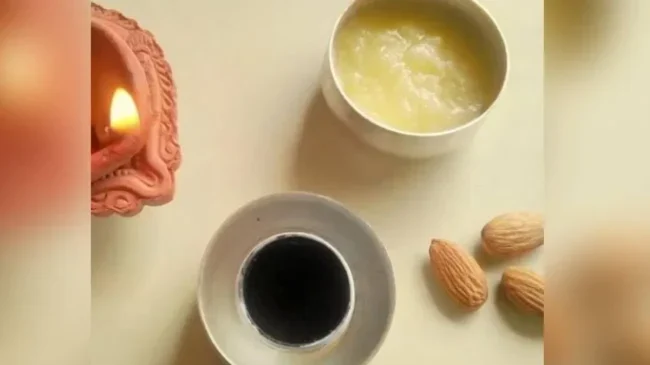Making natural kajal (also known as kohl or surma) at home is a traditional practice in many cultures. Here’s a simple recipe:
Ingredients:
- Sesame Oil or Ghee: 2 teaspoons
- Almond Oil or Castor Oil: 2 teaspoons
- Lamp Wick or Cotton Cloth Strips: To be used as the wick
- Silver or Brass Container: To collect soot
- Airtight Container: For storing the kajal
Instructions:
Prepare the Wick: Cut a piece of lamp wick or cotton cloth strip about 3 inches long. It should fit inside the container with some length protruding out.
Assemble the Setup: Place the wick inside the container in such a way that it stands vertically, leaving some space at the bottom for collecting the soot.
Light the Wick: Light the top end of the wick. Let it burn for a minute or two until it starts producing soot. Blow out the flame, and the wick will continue to smolder and produce soot.
Collect Soot: Hold the container over the flame at a safe distance, allowing the soot to collect inside. You may need to move the container around to ensure even collection.
Repeat Process: Continue burning the wick and collecting the soot until you have a sufficient amount in the container. This may take several rounds, depending on the quantity of kajal you want to make.
Mixing Oils: Once you have collected enough soot, mix it with sesame oil or ghee and almond oil or castor oil. Use equal parts of each oil and adjust the quantity based on the amount of soot you have collected.
Grinding and Storing: Grind the mixture thoroughly using a mortar and pestle until it forms a smooth paste. Transfer the kajal paste into an airtight container for storage.
Usage: Apply the homemade kajal using a thin brush or cotton swab along the waterline of your eyes.
Tips:
- Be cautious while handling fire and hot containers.
- Use natural oils to ensure the kajal is safe for use around the delicate eye area.
- Store the kajal in a cool, dry place away from direct sunlight to maintain its consistency.
- Test a small amount on your skin before applying it to your eyes to check for any adverse reactions.
Preparation:
Ingredients:
- Almonds: 4-5
- Castor Oil or Ghee: 1 teaspoon
Instructions:
Soak Almonds: Soak the almonds in water overnight or for at least 6-8 hours. This helps in softening them, making it easier to grind them into a fine paste.
Peel Almonds: After soaking, peel the almonds to remove the skin. The skin should come off easily after soaking.
Grind Almonds: Grind the peeled almonds into a smooth paste using a mortar and pestle or a grinder. Add a few drops of water if needed to facilitate the grinding process.
Prepare a Wick: Cut a thin strip of clean cotton cloth or use a clean cotton wick from a lamp. Ensure that it’s long enough to dip into the almond paste and protrude out of the container.
Assemble Setup: Take a small, heat-resistant container or a metal lid. Place the prepared wick in the center of the container, letting one end touch the bottom.
Pour Castor Oil or Ghee: Pour a teaspoon of castor oil or ghee into the container, enough to cover the bottom where the wick is placed.
Light the Wick: Light the top end of the wick with a matchstick or a lighter. Let it burn for a few minutes until it starts to smoke.
Collect Soot: Hold the container at a slight angle over the flame, allowing the smoke to collect on the inner surface of the container. The soot will gradually accumulate.
Repeat Process: Keep moving the container to ensure even collection of soot. You may need to relight the wick a few times until you collect a sufficient amount of soot.
Scrape Soot: Using a clean, dry tool like a spoon or spatula, carefully scrape off the collected soot from the container walls.
Mix with Almond Paste: Mix the scraped soot with the almond paste to form a smooth, black mixture. Adjust the amount of soot according to the desired intensity of the kajal.
Store in a Container: Transfer the prepared kajal into a clean, airtight container for storage. Keep it in a cool, dry place away from direct sunlight.
Usage: Apply the homemade kajal using a thin brush or a clean fingertip along the waterline of your eyes.
Notes:
- Ensure that all utensils and tools used are clean and dry to prevent contamination.
- Test a small amount of kajal on your skin before applying it to your eyes to check for any adverse reactions.
- Store the homemade kajal properly to maintain its consistency and prevent it from drying out.







